The CII (Carbon Intensity Indicator) explained in 6 minutes – Nautilus Shipping
Introduction
The International Maritime Organisation is a United Nations agency that adopts and develops regulations to ensure that international shipping is safe, secure and pollution-free.
One of its goals is to ensure that international shipping takes active measures to meet the United Nations Sustainable Development Goal (SDG) targets.
These measures ensure that we use the oceans, seas and all marine resources in a sustainable manner.
Under IMO’s remit, it is the Marine Environment Protection Committee (MEPC) that guides the maritime community on environmental matters. In its 62nd session held in July 2011, the MEPC focused on greenhouse gas matter and introduced the Energy Efficiency Design Index (EEDI) and the Ship Energy Efficiency Management Plan (SEEMP).
The CII is an integral part of the SEEMP. As we enter into 2023, it becomes imperative for ship owners, ship managers and every seafarer to understand the CII.
It becomes a mandatory measure under MARPOL Annex VI and comes into force in 2023.
The CII calculations for all cargo, RoPax, and cruise ships that are over 5000 gross tonnage (GT) and trade internationally must start by 2023 and the first report is to be submitted to the IMO no later than 31st March 2024.
In this article, we try to explain in simple language what CII is, how it is calculated and give examples of measures that we can take to improve it. With that being said, let’s begin.
What is CII?
CII is an acronym for Carbon Intensity Indicator and in three short points, here is what it means:
-
Carbon Intensity Indicator (CII) is a measure of a ship’s pollution capacity. It compares a ship’s carbon emissions to the benefits it provides to society by moving goods through the sea
-
Bigger ships have higher emissions, but they also carry more cargo. Thus, the CII can give a fair evaluation of a ship’s air pollution potential irrespective of size and type of propulsion.
-
The CII rating has five main grades: A, B, C, D and E. The efficiency of the vessel decreases as we go from A to E. Within each grade, we have a range of CII rating values. For instance, a vessel may be on the better or worse side of the C rating. Vessels graded D and E for three years must improve their score.
The CII rating system
The CII provides a rating system to grade ships based on how much air pollution they are responsible for. Such grading of cargo and passenger vessels can help us identify more efficient vessels from less efficient ones.
This allows us to set up incentives for better-performing vessels, thereby encouraging more and more vessels to aim for higher ratings. The administration, port facilities and other stakeholders will provide these incentives.
Ratings from A to E are classified as:
-
A – Major superior performance level
-
B – Minor superior performance level
-
C – Moderate performance level
-
D – Minor Inferior performance level
-
E – Inferior performance level
All vessels must aspire to be at least C-rated. The rating will be recorded in the Ship Energy Efficiency Management Plan (SEEMP).
Any vessel that is rated D or E for three years in a row will have to submit a corrective action plan that explains the efforts that will be taken to achieve an acceptable rating (C or above). This plan must be approved by the flag state administration or any Recognised Organisation (RO).
Step-by-step CII calculation
We will understand these calculations by doing a sample calculation. In our case, let us assume a bulk carrier of 60,000 DWT needs to be categorized as either A, B, C, D, or E depending on its CII values.
To understand where our ship lies, we must first understand and calculate three types of CII values – Reference CII, Required CII and Attained CII.
Reference CII (CIIref)
Reference CII is the initial CII value from 2019. To find this value for a vessel, you need the following table.
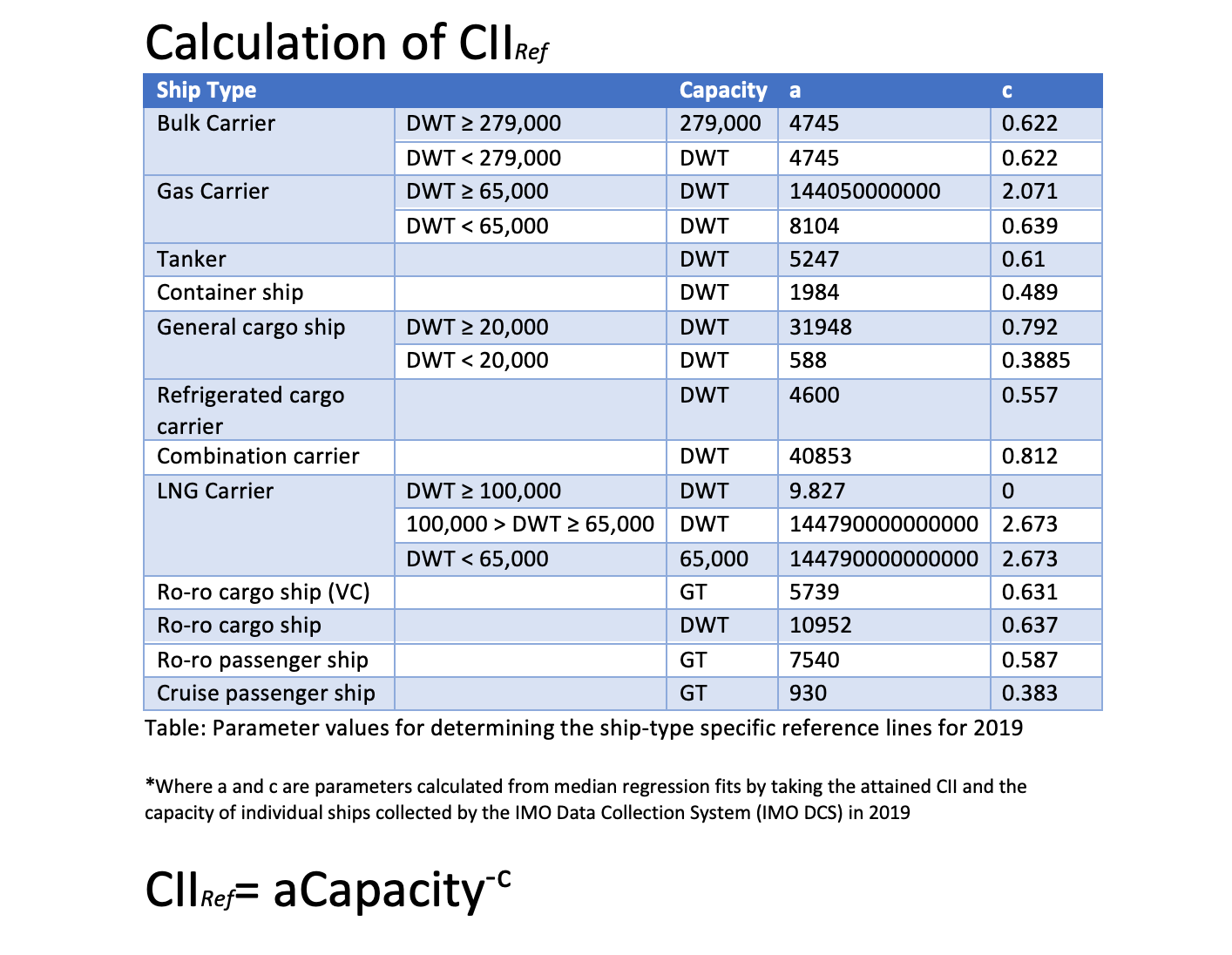
In our sample calculation, the bulk carrier’s deadweight is 60,000 tonnes. The CIIref value for it will be:
CIIref = a * Capacity^(-c)
Therefore,
CIIref = 4745 * 60000^(-0.622)
CIIref = 5.061
Required CII
The required CII is the new CII that the vessel must adhere to. The value of the required CII depends on the reduction factor for the year. With every passing year, the CII limits will become stricter.
Required CII = CIIref* [(100- Z)/100], where Z is the reduction factor for the year.
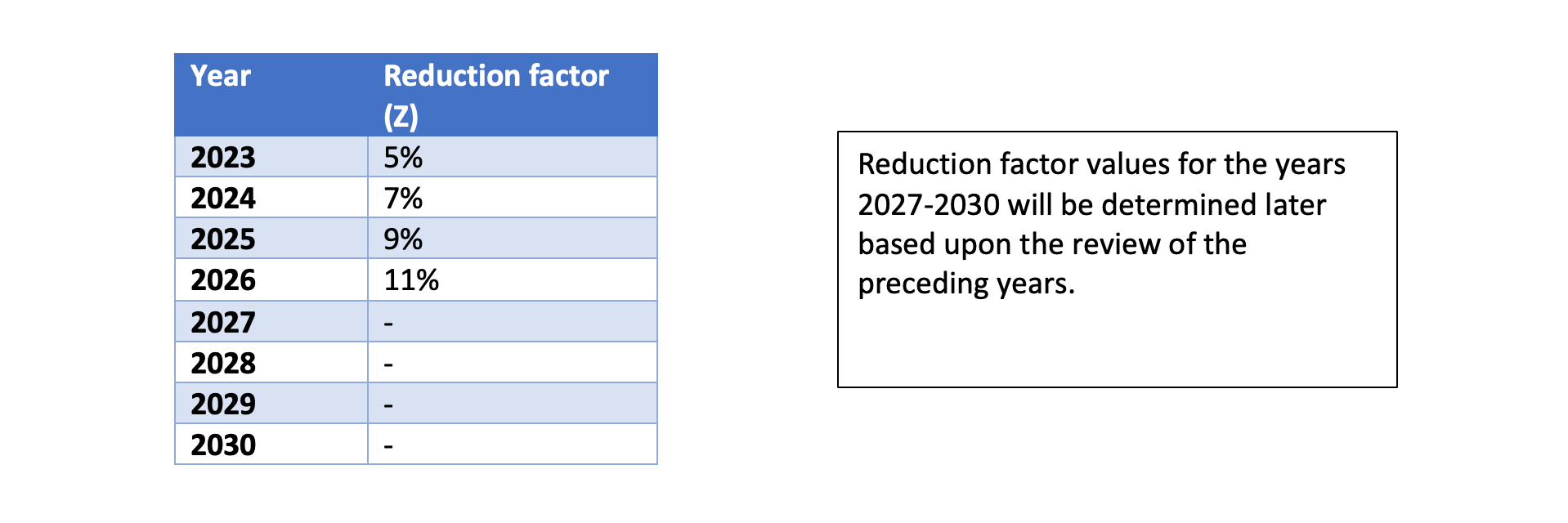
Suppose for our 60000 DWT bulk carrier, we need to calculate the required CII for the year 2023, we would have to reduce CIIref by 5%.
Thus,
Required CII = CIIref *[(100-Z)/100]
= 5.061 * [(100-5)/100]
= 5.061 * 0.95
Required CII = 4.808
Attained CII
This is the actual CII of the vessel for the year in question. The Attained CII calculation is carried out by dividing the grams of CO2 emitted by vessels per tonne-nautical mile of operation.
In our case, let us assume that the bulk carrier carries a cargo of 60,000 tonnes over 12000 nautical miles and releases 3219 tonnes of CO2 in the process.
The Attained CII calculation is carried out by dividing the grams of CO2 emitted by a vessel per tonne-nautical mile of operation.
Attained CII = CO2 emission in grams/(cargo carried or deadweight * Distance travelled in nautical miles)
Therefore,
Attained CII = (3219 * 10^6)/ (60000 * 12000)
Attained CII = 4.471
CII rating
The CII rating is the division of Attained CII by the required CII.
The rating is what helps us determine which grade the vessel belongs to.
CII Rating = Attained CII/ Reference CII
In our case,
CII Rating = 4.471/4.808
CII rating = 0.93
This rating is compared with the following table to determine the vessel grade.
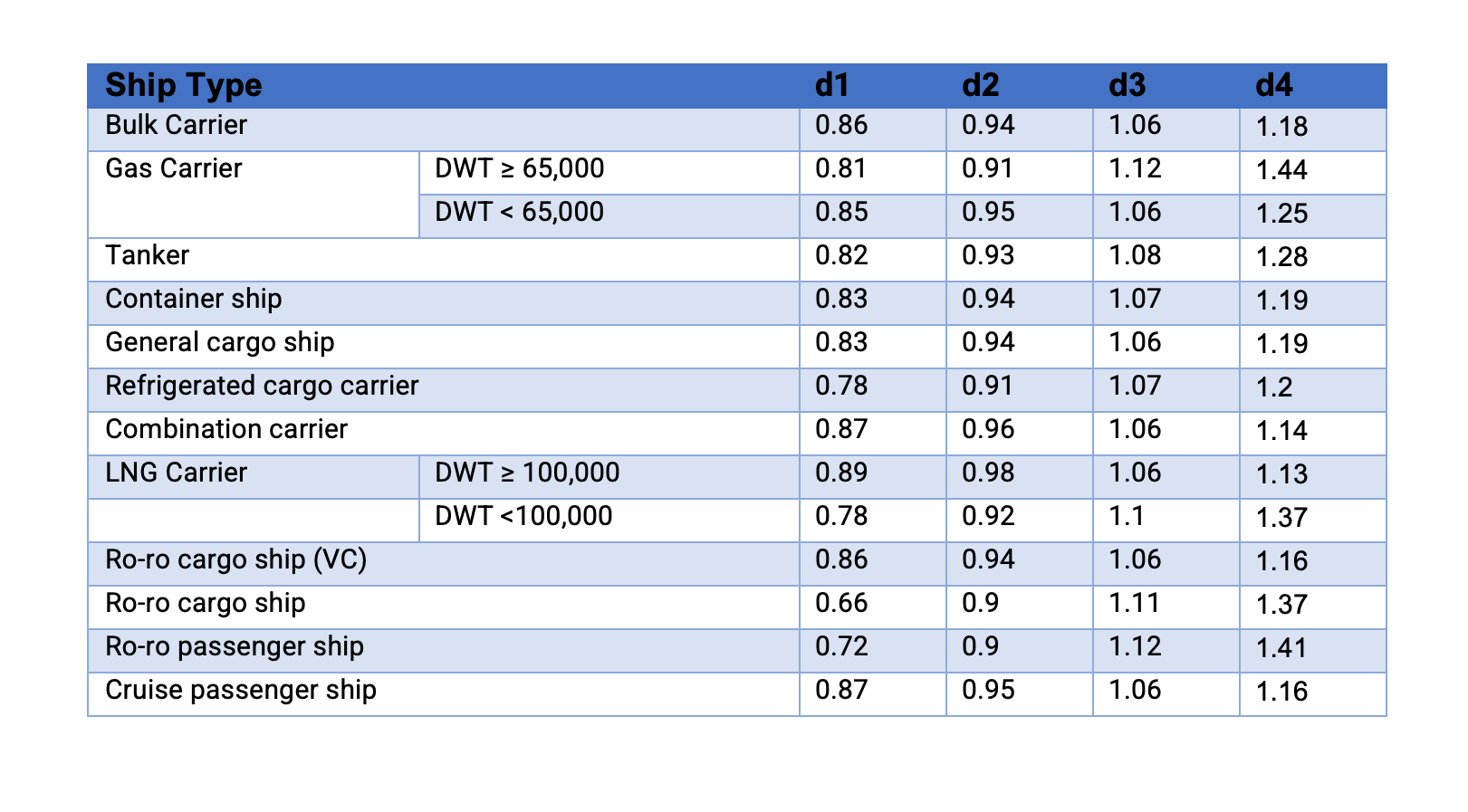
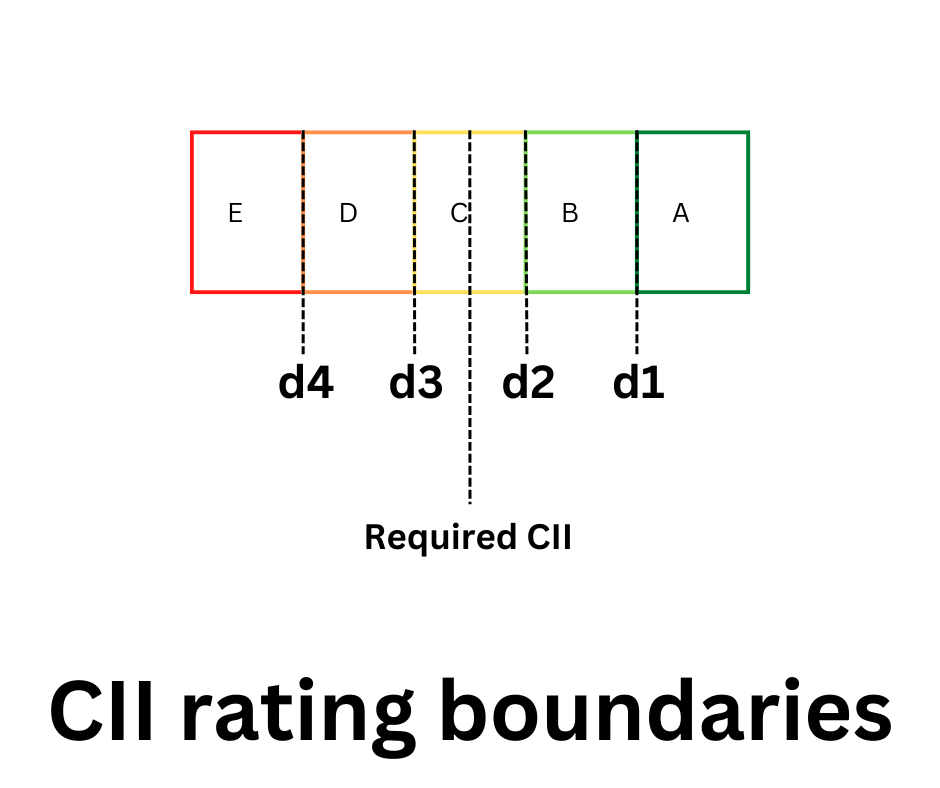
Given that our bulk carrier’s CII rating is 0.93, we compare it from the table’s first row for bulk carriers and find 0.93 to lie between d1 (0.86) and d2 (0.94).
Using the CII rating boundaries diagram, we can see that when the CII rating is between d1 and d2, the grade is B.
CII ratings for future years
Over the years, as the reduction factors increases, the required CII will get harder to maintain. Vessels will have to keep improving the efficiency of their vessels or risk getting downgraded.
Let us explain this with our bulk carrier example.

If we do not improve upon the Attained CII, the vessel will get downgraded over the years and may attract penalties and other losses.
How to improve your vessel’s CII
As can be concluded from the calculations, the CII is a straightforward measure of how efficiently a ship runs.
Thus, any measures that can improve the overall efficiency of a ship will help us improve the CII grade.
The owners and ship managers may choose from measures such as the following to reduce their carbon dioxide emissions and improve the amount of distance travelled per tonne of fuel.
Hull Coatings
Hull coatings can help us reduce drag and improve the amount of distance travelled per tonne of CO2 emission
Low-energy light bulbs
Low-energy light bulbs will reduce fuel consumption thereby reducing the amount of CO2 emission per tonne-nautical mile.
Alternative power generation
Equipment such as shaft generators and 4x Rotor sails reduce the Attained CII value and improve the CII rating and the vessel grade. These options can help reduce CO2 and greenhouse gas (GHG) emissions by up to 25%.
Using a shaft generator, 2x Rotor sails, hybrid and solar energy systems can reduce emissions by up to 16%.
The use of hybrid systems and switching to shore connection when possible will further reduce emissions.
Shaft generator air lubrication
Using air lubrication for the shaft generator can help reduce frictional losses, leading to higher efficiencies and better CII ratings. This alternative has the potential to reduce CO2 and GHG emissions by 7 – 10%.
Optimised rudder design
Optimised rudder designs such as the Gate rudder system can reduce emissions by up to 9%. With air lubrication, the rudder system can reduce emissions by up to 13%.
Optimised propeller design
An optimised propeller design can help us reduce CO2 and GHG emissions by 5 – 7%.
Alternative fuels
Switching to cleaner fuels is also an option in compatible engines. Cleaner fuels by nature produce lesser emissions over the same distance thereby reducing the CII value and improving the vessel grade.
To sum it up
While the goals set by the IMO may seem strict at first glance, they do open the gates to a much greener, more responsible and more sustainable way of carrying out international shipping.
The Carbon Intensity Indicator is a much-needed operational measure to create lasting improvement in the maritime industry.
Apart from using energy-efficient technologies, other methods such as limited power and speed, energy optimisation and fuel flexibility, and electrification are all very good alternatives to keep a ship’s CO2 and GHG emissions in check.
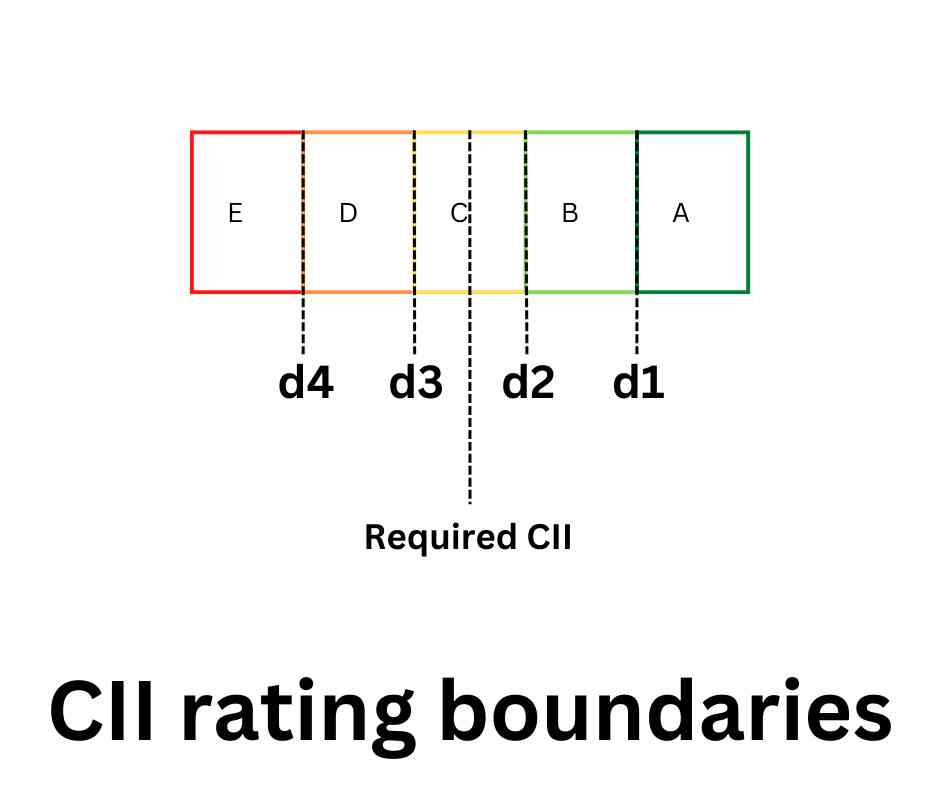
Leave a Reply